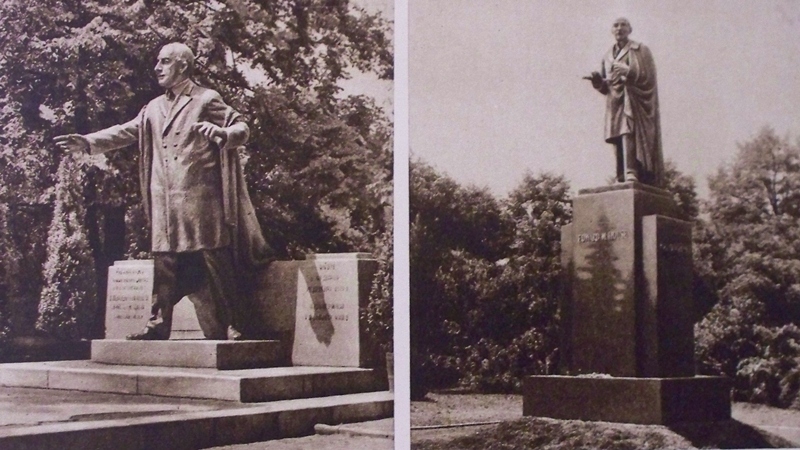In Budapest, there is a Park of Statues for tourists that never experienced Communism. János Pótó, in his excellent book (Places of memory, 2003), wrote about the ’athletic’ (i.e. mobile despite being a monument) history of the Bandholtz statue. This is not only the case in Hungary.
While erecting a statue for Woodrow Wilson never surfaced in Hungary, in Prague, a railway station bears his name and he also has a statue. The latter is also the case in Poznan. In 1919, squares were dedicated to Wilson who was celebrated as the prophet of a new world. Then came Nazis, later, Communists and Wilsonian memory places disappeared from the map. The year of miracles, 1989, brought an end to this tendency and Wilsonian memory places appeared again.
Let us start with the story of the statue in Prague. It was erected in 1928, after Wilson’s death, to appreciate his role in creating the Czechoslovak ’nation state’. It was placed in front of the old railway station that had born Emperor Franz Joseph’s name earlier and that was also renamed Wilson. The next landmarks are 1938 and the attack on Pearl Harbour. After Germany and the USA had declared war on each other, on the night of 11 December 1941, the three-meter tall statue was broken into pieces at the order of Reinhard Heydrich (’deputy protector of the Protectorate of Bohemia and Moravia’). The bronze material was used to cast bullets. Following the Communist takeover, the railway station was also renamed since such an important institution could not bear the name of an American, i.e. an enemy. After the Velvet Revolution of 1989, the main railway station was yet again called Wilson Station.
In 2008, an organization called the American Friends of the Czech Republic initiated that the president’s statue should be erected again. They received 13 proposals in 9 months and finally they decided that they would realize the one that is closest to the original statue. It was Albin Polasek, head of the sculpting department of the Art Institute of Chicago (1920–50) who created the original statue. Just like the statue itself, its original location is also no more. In the 1970s the Communist government attached a new wing to the railway station in the area where the statue of Wilson used to be. Currently, the location is the roof of a parking lot, therefore, the statue was eventually erected in front of the new wing in 2011. The House- statue of Warsaw, which is also on the postcard, has witnessed similar upheavals. In 1951, the Polish Communists destroyed it, then, at the initiative of the Polish community living in the USA, a faithful copy of the original was erected in 1991. ’Colonel’ Edward Mandell House (he gave the rank to himself), who would be in the words Peter Grose, Wilson’s second self, was the non-official security advisor of the president and played a key role in achieving the independence of Poland.
The Wilson Square in Warsaw was called the Square of the Commune of Paris for four decades. Today, it bears the name of the 28th President. Herbert Hoover also has a square in Warsaw. However, it was not totalitarian dictatorships but weather that destroyed the statue (made of sandstone) that stood there. In the Polish capital there is a street named after Edison and there is a statue of Reagan, too.

Perhaps, I do not even have to tell what happened to the Wilson park and statue of Poznań: Nazis destroyed the full-body statue made of bronze, then, the Communist renamed the park. The artist of the original one was the same USA artist of Danish origin, John Gutzon de la Mothe Borglum, who sculpted the monument of Mount Rushmore. The end, or, rather, the current state of the story differs from the ones above in the sense that there is a new monument there, a bust standing on a tall column. Since 1994 the park is again called Wilson park and the new statue stands, too.
There was a Wilson square in Zagreb between 1919 and 1927. The president played a key role in creating the Southern Slavic state. Subsequently, the place was called Square Alexander I, Square no.1 then Theatre Square. All these took place between 1927 and 1946. It was renamed Tito Square and it is still called that way. Since 2008 there has been a debate about whether it should remain Tito Square. Some believe it should be called Wilson Square, others think it should be Theatre Square.
Such acts of memory- and identity politics are not there to bring back the totalitarian dictatorships of the 1930s to the heart of 21th century Europe, instead, they serve the same purpose as Civil War memorials in the New World. They contribute to talking of and overcoming traumatic past. Yet, the situation in Central Europe is somewhat different from what we see in North America: Totalitarian dictatorships did all they could to prevent talking of traumas and memory. There are few from the USA that understand this. Professor Larry Wolff, director of European and Mediterranean Studies program of the New York University, is one of them Larry Wolff who wrote an excellent book about the invention of Eastern Europe: Inventing Eastern Europe: The Map of Civilization on the Map of the Enlightenment (Stanford University Press, 1994).






